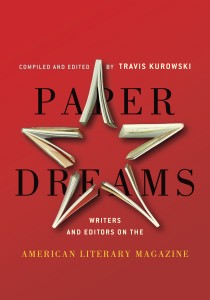 Paper Dreams: Writers and Editors on the American Literary Magazine
Paper Dreams: Writers and Editors on the American Literary Magazine
Edited by Travis Kurowski
Atticus Books, August 2013
432 pages / $29.95 Buy from Atticus Books or Amazon
In 1891, Henrik Ibsen’s Ghosts set off one of the most dazzling and hilarious newspaper battles in the history of London theater. From just two private performances, the play garnered over 500 printed editorials, responses, and reviews, catapulting it into instant infamy and consequently playing a part in moving English theater a few steps closer to full-fledged theatrical modernism. Ibsen’s play is only one example of the inverse relationship between aesthetic influence and commercial success that seems to be part and parcel of much modernist art. The literary magazine is, of course, no exception. In Paper Dreams, a new anthology from Atticus Books, Eric Staley echoes this sentiment when he says that “the best the literary magazine can hope to achieve is influence out of proportion to circulation.”
Paper Dreams recounts over a century of literary magazine history in the United States through primary and secondary sources, ranging from editorial pronouncements by Ezra Pound (a nearly ubiquitous editorial presence early in the 20th century) to the savvy branding strategies of George Plimpton (The Paris Review’s luminous impresario) and beyond to the current renaissance of literary journals flourishing on the internet like PANK, Brevity, and The Rumpus. The aim of the anthology is, as editor Travis Kurowski puts it, to trace “the backbone and the outer rings of American literature.” Kurowski—a creative writing and publishing teacher at York College of Pennsylvania—began the project back in 2008 for The Mississippi Review and continued to research the topic because he wanted to, as he says in an interview, combat his ignorance on the subject. Paper Dreams certainly made me come face-to-face with my own.
Although there are so many wonderful pieces that deserve comment, my particular favorites are the ones that do some much-needed historical re-visioning. Jayne Marek’s “Making Their Ways: Women Editors of ‘Little’ Magazines” and Linda Lappin’s “Jane Heap and Her Circle” work to reclaim the editorial reputations of Margaret Anderson and Jane Heap of the Little Review. Marek states, “[I]t is clear that women had far more to do with the support and evolution of modernism than has been generally acknowledged.” And Abby Arthur Johnson’s article, “Forgotten Pages: Black Literary Magazines in the 1920s” reintroduces the reader to important black periodicals like the Saturday Evening Quill, Black Opals, Stylus (which produced Zora Neal Hurston), and Harlem and Fire (both which included Langston Hughes as a founding member).
In terms of the contemporary moment, the 2008 roundtable on the literary magazine was the most compelling. On the one hand, it revealed that not too much has changed in the last century. Editors still want to discover new talent, still hope to find that next great voice and all while dealing with perpetual money woes. They also continue to worry that there are too many journals and too few readers. As Algernon de Vivier Tassin said in 1916, “However barren were some departments of literature in the early days . . . magazines indicated at the outset their eternal disposition to multiply faster than the traffic will stand.” On the other hand, some things have indeed changed—the Internet, of course, being the most obvious. The distributive powers of the Internet are truly staggering; however, its ability to generate “noise” is equally awe-inspiring. Jill Allyn Rosser has the most interesting thing to say about the role of the literary magazine in our electronic age: “I don’t think that really happens anymore—the salon—and the magazine has become a replacement for that.” I am not sure if that is the case, but I want it to be true.
Although only one person discussed it in the anthology, submission fees might be a topic that needs to be addressed as we consider the future of publishing. Megan M. Garr, editor of Versal, admits she now charges for submissions. (To be fair, she also pays her contributors). As I see it, this phenomenon, which appears to be increasingly common, could spoil the so-called literary magazine renaissance. Already, authors are finding they can’t submit to the journals/presses they’d like to because of the prohibitive cost. Not only are they not getting paid for their work, which, for the most part, has always been the case, they must now pay for the privilege of publishing in the journals whose existence is ostensibly to support their work. I don’t see a problem with those lit magazines and small presses that send the author a book or give the author a subscription or something, but I worry about the long-term effects of this gate-keeping strategy.
Ultimately, I am in agreement with Rick Moody who said, “I think the quarterly, by and large, should be a sloppy mess, full of experiments, full of heterodoxy, full of failure, even, but never ever dull.” I think Paper Dreams captures that same sense of heterodox fun, and it is rarely dull. It is a must-read for the scholar and for contemporary writers who, like myself, had no idea just how rich a history in lit magazines we have.
***
Carlo Matos has published four books: A School for Fishermen (BrickHouse Books), Counting Sheep Till Doomsday (BlazeVOX), Ibsen’s Foreign Contagion (Academica Press), and Big Bad Asterisk* (BlazeVOX). He has also published poems, stories and essays in Prick of the Spindle, Word Riot, The Conium Review, Saudade Review, Atticus Review, The Rumpus, Paper Darts, Arsenic Lobster, DIAGRAM, and the Gavea Book of Portuguese-American Poetry, among others. He currently lives in Chicago, IL where he teaches English at the City Colleges of Chicago by day and is a cage fighter by night. After hours he can be found entertaining clients at the one and only Chicago Poetry Bordello.
Tags: Carlo Matos, Paper Dreams: Writers and Editors on the American Literary Magazine, Travis Kurowski
